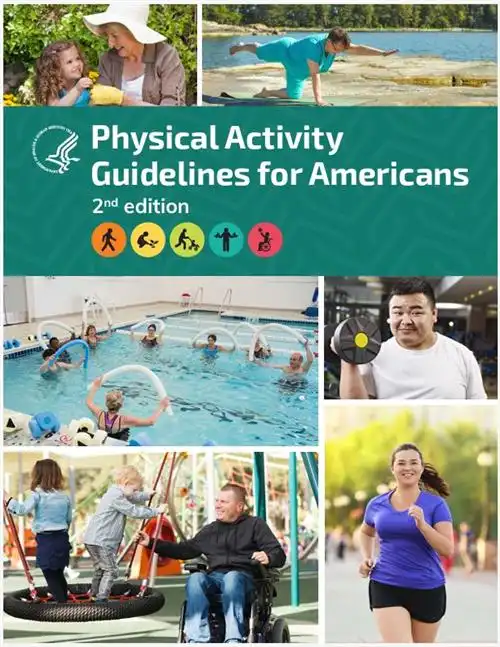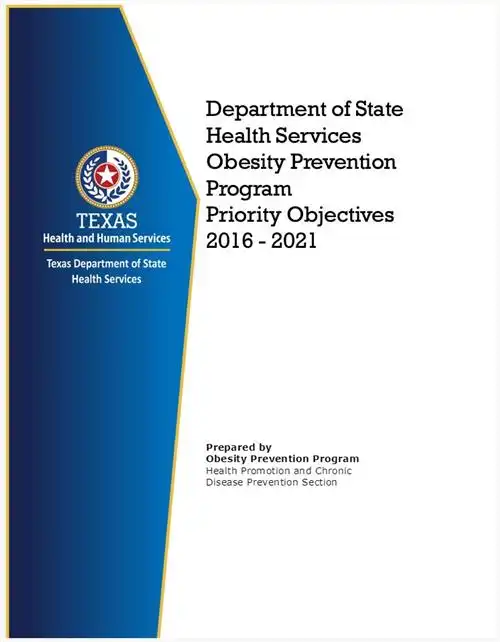Welcome to the Family & Community Health & Fitness Resource page
Find helpful resources to explore for better health and wellness for the entire family.
Health Related Topics
Texas Tobacco Quitline
From https://www.yesquit.org/
The Texas Tobacco Quitline is a toll-free service available for those ages 13 and older who want to quit tobacco or are thinking about quitting tobacco. Call the Quitline at 1-877-YES QUIT (1-877-937-7848) or by visiting www.yesquit.org to learn more about how you can quit tobacco.
Easy to pick up, hard to put down
This time, try something different. We can help you become an expert in living tobacco-free. We’ve been doing this for 25 years, so believe us when we tell you we can help double your chances of quitting for good. Anyone can get help from our free Texas Quitline service and Web-based program.. The Texas Tobacco Quitline can help you quit all forms of tobacco, including e-cigarettes. For more information and other resources on e-cigarettes and vaping visit the DSHS Vaping Website.
|
Quitting tobacco isn’t easy. Your body, memory, and the habit itself fight you every step of the way. Plus, it can take several attempts to successfully quit. By calling the Quitline, you’ll receive personalized support and the tools and strategies to help you become tobacco-free. Parental permission is not required for youth. Our clinically proven program is free and confidential, helping you stay focused on your personal reasons for quitting.
|
When you join our program, we’ll help you create an easy-to-follow online Quitting Plan that will help you get ready, take action, and live the rest of your life tobacco-free. Web Coach® will provide you with access to a private, online community where you can complete activities, watch videos, track your progress and join in discussions with others in the program.
|
My Plate - U.S. Department of Agriculture
Learn how to eat healthy with MyPlate
Remember the food pyramid? Meet MyPlate, the official symbol of the five food groups. Learn how to make MyPlate work for you.
Discover budget-friendly food ideas
Healthy food choices don’t have to cost a lot. Find SNAP savings in your area and discover new ways to prepare budget-friendly foods in Shop Simple with MyPlate.
Featured
Set personal goals for healthy eating
Build healthy eating habits one goal at a time! Use the Start Simple with MyPlate app to pick simple daily food goals, see real-time progress, and earn badges along the way.
Find easy, low-cost recipes
View delicious recipes in our very own MyPlate Kitchen! Search by ingredient to use what you already have or browse by category to find something new. Save your favorites, make personalized cookbooks, and more!
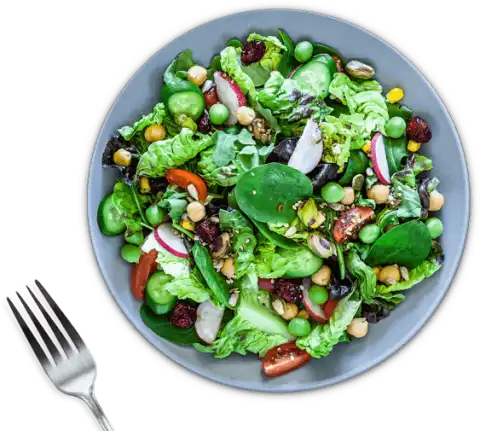
Sign up for updates!
Can’t get enough of MyPlate? We can’t either. Submit your email to stay in the loop on new tips, features, recipes and more.
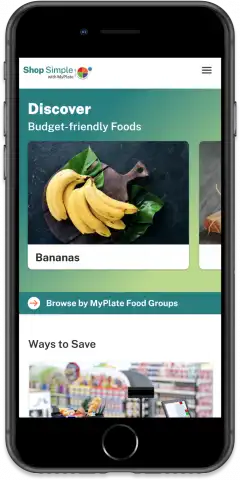
Shop Simple with MyPlate
Find savings in your area and discover new ways to prepare budget-friendly foods.
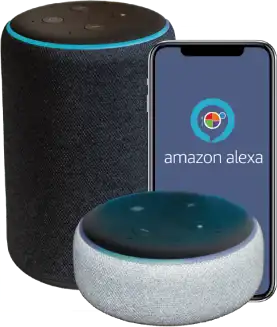
MyPlate on Alexa
Get MyPlate nutrition tips on Amazon Alexa devices or the free Alexa app.
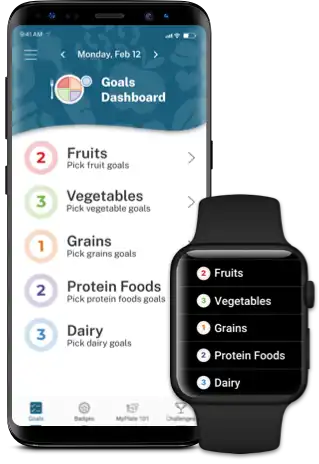
Start Simple with MyPlate App
Build healthy eating habits one goal at a time! Download the Start Simple with MyPlate app today.

MyPlate.gov is based on the Dietary Guidelines for Americans, 2020-2025
Whole Child, Whole Family Health
From Kohl's Healthy at Home and Alliance for a Healthier Generation webpage linked here.
Kohl’s and Healthier Generation are helping families prioritize healthy living and create home environments where everyone can thrive. Kohl's Healthy at Home is a hub of proven tips, activities, and resources designed for parents and caregivers – so the healthy choice is the easiest choice for families.
Get family health resources via text messages
Text “HEALTHY” to 1-800-436-4584 to receive weekly text messages with encouragement, tips, and activities to help you and your family lead a healthy life.
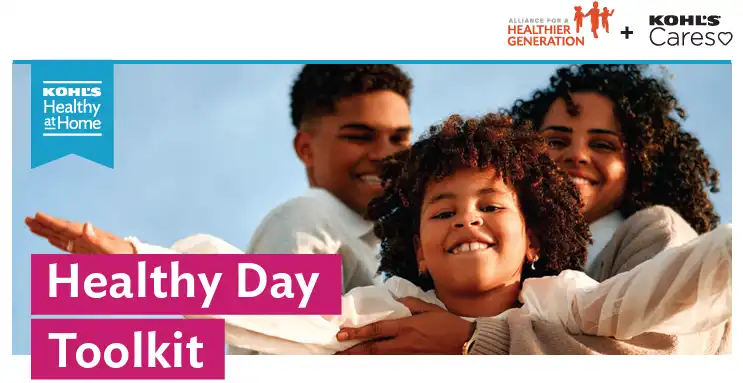
Resource Collections
 |
Eating Healthy |
Bite-size changes can have a big impact on helping families make mealtimes more enjoyable and nutritious.
|
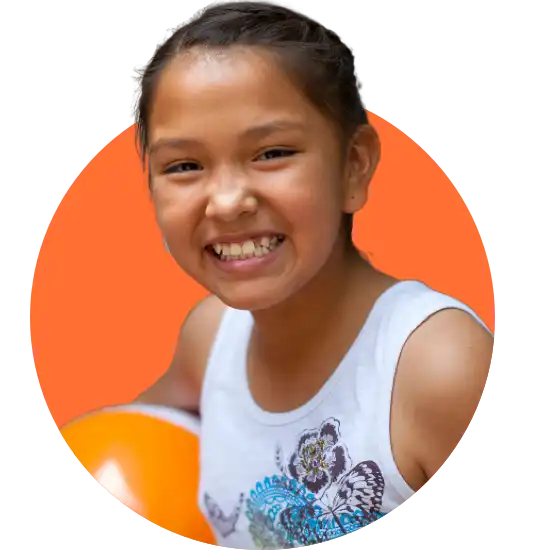 |
Moving More |
Daily physical activity supports curiosity, learning, and social-emotional health.
|
 |
Feeling Healthy |
Feel calm, confident, and connected by building social-emotional skills together.
|
 |
En español |
Herramientas gratuitas, recursos, recetas y más para tener un impacto positivo en la salud y el bienestar de su familia.
|
 |
Celebrating Health |
Explore curated resources honoring National Hispanic Heritage Month, Asian American Native Hawaiian Pacific Islander Heritage Month, Black History Month, and more.
|
Connecting Conversations: Tips for Supporting Communication between Parents/Caregivers and Their Children and Teens
From Adolescent and School Health webpage linked here.
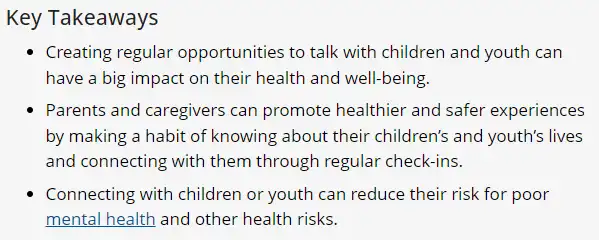
There are actions you can take to encourage open communication. This means that your child or teen feels free to express their feelings and ideas to you. Open communication can help strengthen your relationship with your child or teen.
Conversation Starters
Here are some ways you can start conversations with your child or keep conversations going with them.
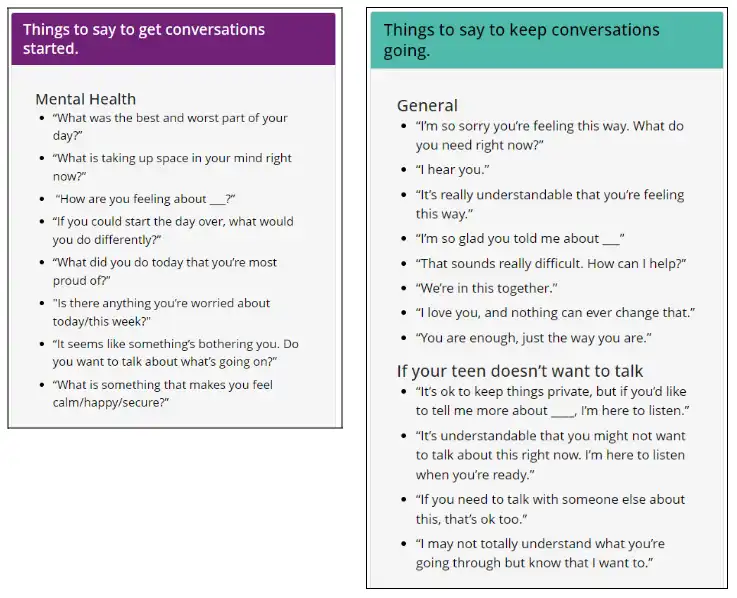
Resources
If you have concerns about your child’s emotional well-being, behavioral adjustment, or overall mental health, reach out to a qualified professional like your primary care provider or your child’s pediatrician. Continue to have open and honest discussions with your child, offering encouragement and support.
Need Support Now? If you or someone you know is struggling or in crisis, help is available. Call or text 988 or chat 988lifeline.org.
If you, or someone you know, needs help with a mental or substance-use disorder, call SAMHSA’s National Helpline at 1-800-662-HELP (4357) or TTY: 1-800-487-4889, or text your zip code to 435748 (HELP4U), or use SAMHSA’s Behavioral Health Treatment Services Locator to get help.
Learn more about:
Vaping Prevention & Education
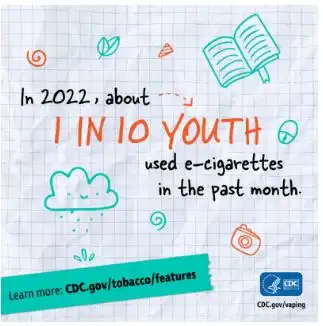
According to the Centers for Disease Control and Prevention (CDC):
E-cigarettes are electronic devices that heat a liquid and produce an aerosol, or a mix of small particles in the air. This aerosol is breathed into the lungs of the person using the device. E-cigarette aerosol can contain harmful and potentially harmful substances. While use of e-cigarettes is unsafe for everyone, this is especially true for kids, teens, and young adults.
E-cigarettes, or vapes, are known by many different names. They are also called “e-cigs,” “e-hookahs,” “mods,” “vape pens,” “tank systems,” and “electronic nicotine delivery systems (ENDS).” E-cigarettes come in many shapes and sizes. Some are made to be recharged, some to be refilled, and some to be thrown away (disposable).
E-cigarette Use Among Youth
E-cigarettes are the most commonly used tobacco product among U.S. middle and high school students.
- In 2022, about 1 in 10 or 2.55 million U.S. middle and high school students used e-cigarettes at least once in the past 30 days, including 3.3% of middle school students and 14.1% of high school students.
Disposable e-cigarettes are the most commonly used device type among U.S. middle and high school students who vape. In addition, nearly 85% of middle and high school students who used e-cigarettes reported using flavored e-cigarettes. Many e-cigarettes come in kid-friendly flavors—like candy, desserts, other sweets, mint, and menthol. This makes them more appealing to youth.
- Among middle and high school students who currently used any type of flavored e-cigarette in 2022, the most commonly used flavors were fruit (69.1%), candy, desserts, or other sweets (38.3%), mint (29.4%), and menthol (26.6%).
Health Risks of Vaping for Youth
Vaping can have health risks for youth. Most vapes have nicotine in them, which is highly addictive. Nicotine use in adolescence:
- Can harm brain development, which continues until about age 25.
- Can impact attention, learning, mood, and impulse control.
- May increase risk for future addiction to other drugs.
Not only can nicotine in e-cigarettes pose health risks for youth, but youth who vape may also be more likely to go on to use regular cigarettes.
In addition to nicotine, e-cigarette aerosol can contain other harmful and potentially harmful substances. These substances include:
- Cancer-causing chemicals
- Volatile organic compounds
- Ultrafine particles
- Flavorings that have been linked to lung disease
- Heavy metals such as nickel, tin, and lead
Nicotine Addiction Can Be a Source of Stress
When a person is dependent on (or is addicted to) nicotine and stops using it, their body and brain must get used to not having nicotine. This can result in temporary symptoms of nicotine withdrawal. People might keep using tobacco products, like vapes, to try to make these symptoms feel better. Nicotine withdrawal symptoms include:
- Irritability
- Restlessness
- Feeling anxious or depressed
- Trouble sleeping
- Problems concentrating
- Craving nicotine
Youth might turn to vaping to try to deal with stress or anxiety. This can create a cycle of nicotine addiction, which can also be a source of stress.
Youth vaping and cigarette use have also been linked to mental health symptoms, such as depression.
Helping Youth Quit Vaping
Most students who use tobacco products want to quit and have attempted to do so. This includes e-cigarettes. In 2020, nearly 2 in 3 middle and high school students who used e-cigarettes reported wanting to quit. Similarly, about 2 in 3 reported trying to quit in the last year.
Youth who vape need support and help when trying to quit. Talking to youth and connecting them with quitting resources is a great way to help.
What Parents Can Do to Reduce Vaping Among Youth
Parents can play an important role in protecting youth from the risks of vaping. Sometimes, it’s hard to know what to do to help youth avoid or quit vaping. Engaging youth and starting a discussion can help. Here are some suggestions.
Parents can:
- Set a good example by being tobacco-free.
- Try to ensure your child is not exposed to the secondhand smoke or aerosol from any tobacco products, including e-cigarettes.
- Talk to your child about why vaping is harmful for them. It’s never too late to have that talk.
- Let your child know you want them to stay away from all tobacco products, including e-cigarettes, because they are not safe for them.
- Reach out to your child’s health care provider for quitting resources.
Vaping Prevention and Education Resource Center
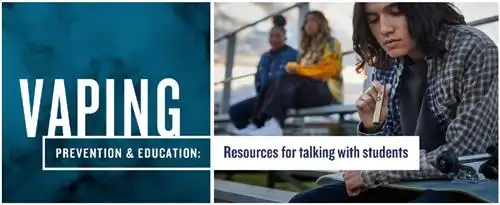
The Vaping Prevention and Education Resource Center provides free science-based materials to help students understand the dangers associated with vaping and nicotine addiction. It includes free materials for parents and teens.
- Parents will find fact sheets, videos, and resources to help them understand and recognize vapes, talk with their children, and keep the conversation going over time.
- Students will find real-life stories and relatable content to help them understand vaping, nicotine addiction, common myths about vapes, and how to say no to vaping.
November is National Diabetes Month
During National Diabetes Month in November, we encourage all people to learn about diabetes, find resources, and bring attention to the impact of diabetes in communities across the nation.
From the Texas Department of State Health Services website...
Over time, having high blood sugar can cause serious health problems. You can prevent or delay these problems by eating healthy meals, being physically active, monitoring your blood sugar, and taking the medicine your doctor prescribes. Although there is no cure, millions of people with diabetes enjoy long, full lives, and you can, too.
November is National Diabetes Month, a time when communities across the country seek to bring attention to diabetes. This year’s focus is on taking action to prevent diabetes health problems.
Diabetes is a disease that occurs when your blood glucose, also called blood sugar, is too high. It affects about 37 million Americans, including adults and youth. Diabetes can damage the eyes, kidneys, nerves, and heart, and it is linked to some types of cancer.
But there’s also good news: Taking charge of your health may help you prevent diabetes health problems.
Tips to get started
Manage your blood glucose, blood pressure, and cholesterol levels.
Research shows that managing your diabetes as soon as possible after diagnosis may help prevent diabetes health problems. You can start by managing your diabetes ABCs.
- A is for the A1C test that health care professionals use to measure your average blood glucose levels. Some people with diabetes also use devices to track their blood glucose throughout the day and night.
- B is for blood pressure.
- C is for cholesterol.
Ask your health care team what your ABCs goals should be.
Take small steps toward healthy habits.
Lifestyle habits such as planning healthy meals, being physically active, getting enough sleep, and not smoking may help you manage your diabetes ABCs. You don’t have to do it all at once. Start slow and build healthier habits from there.
Take your medicines on time.
Remember to take your medicines even if you feel healthy. Talk with your doctor or pharmacist if you have trouble taking your medicines on time or at the correct dose.
Reach or maintain a healthy weight.
If you have overweight or obesity, ask your primary care provider if healthy eating, physical activity, or other weight-loss treatments may help you manage your weight.
Take care of your mental health.
Managing diabetes can be hard. If you feel down, sad, or overwhelmed, learn about healthy ways to cope with stress. Consider talking to a mental health counselor or joining a support group.
Work with your health care team.
Managing diabetes takes a team. Your health care team may include a primary care provider, diabetes specialist, registered dietitian, or certified diabetes educator. Ask your primary care provider if you should talk with other health care professionals about your diabetes.
Diabetes medicines, devices, and office visits can be expensive. A social worker or a member of your health care team may be able to help you find community resources or financial help for diabetes care.
October is Fentanyl Awareness Month
Let's come together in October to raise awareness about the dangers of fentanyl and stop accidental fentanyl poisoning that has led to countless tragedies.
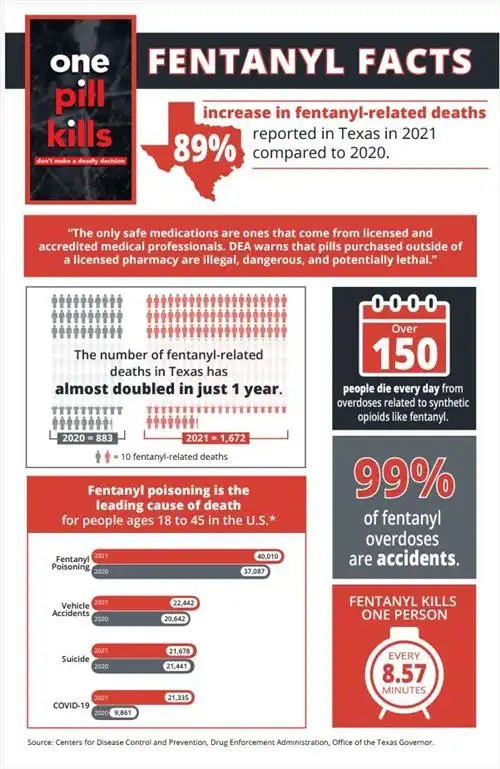
Download Fentanyl Fact Sheet (PDF)
Fentanyl is safe when taken as prescribed by a doctor to treat severe pain. However, illegally manufactured fentanyl is often added to counterfeit (fake) pills and other substances with or without a person's knowledge, including:
Counterfeit (fake) pills made to look like pills that come from a pharmacy, such as:
- Oxycodone
- Vicodin
- Percocet
- Xanax
- Adderall
Other illegal substances, such as:
- Heroin
- Cocaine
- Methamphetamine MDMA (also known as “ecstasy” or “Molly”)
The overdose crisis is harming Texas youth at an especially alarming rate. Teenagers and young adults can buy illegal substances and counterfeit pills through social media—and many may be mixed with potentially fatal doses of fentanyl.
Even small amounts of fentanyl, equivalent to a few grains of sand, can be deadly. That means that any pill could be the one that causes an overdose. Remember, one pill kills.
Protect Yourself, Your Family and Your Fellow Texans from the Dangers of Fentanyl
Accidental fentanyl overdoses are life threatening, but preventable. Here are some ways to keep yourself and your loved ones safe from a fentanyl overdose.
Talk about fentanyl
Make sure your child understands the risks of fentanyl and how even one pill can result in accidental overdose. If you're concerned about a loved one who uses substances, have a calm, direct conversation and listen without judgment. Work together to make a plan to stay safe.
Only take pills prescribed to you
If it didn't come from your doctor or pharmacist, you can't be sure that it's safe.
Get the facts: txopioidresponse.org/fentanyl
Together, we can save lives.
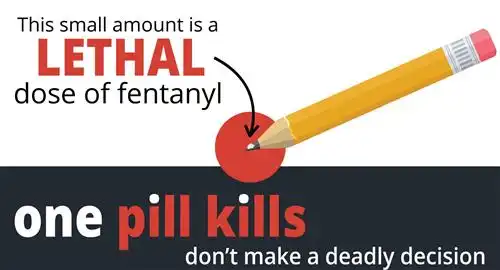
Additional Resources
- The United States Drug Enforcement Agency has a dedicated parent/guardian page with multiple resources available.
- The National Institute of Drug Abuse has created a resource of conversation starters about substance use and how to talk with teens about substance use.
- The Texas Health and Human Services Department Texas Targeted Opioid Response website has information about how to seek help for yourself or someone else.
September is Suicide Prevention Awareness Month
Every year in September, suicide prevention advocates around the United States host events and provide training to raise awareness about suicide. In 1975, the American Association of Suicidology sponsored the first National Suicide Prevention Week.
The goals are to educate and inform the public about suicide prevention, the warning signs, and to decrease stigma, thereby encouraging help-seeking. On September 10, 2003, the International Association for Suicide Prevention and the World Health Organization worked together to dedicate one day each year to share the message that suicides are preventable and provide messages of hope and help. The goal was to direct people who may be struggling with thoughts of suicide to care. World Suicide Prevention Day is now observed in over 60 countries. National Suicide Prevention Week is observed the week corresponding with World Suicide Prevention Day.
In 2008, September was first observed as National Suicide Prevention Awareness Month. This September, get involved in an event in your community to raise awareness about suicide and promote help-seeking. Take advantage of opportunities to learn more about how you and others can support suicide prevention efforts.
The Tiny Evie Rocks Story Providing Hope to Those Impacted by Suicide
Tiny Evie Rocks is a non-profit organization located in Tyler, dedicated to empowering community members to come together, spread kindness, enjoy exceptional music, access local resources, and gain life-saving knowledge. Tiny Evie Rocks was born out of the experience of Michael and Jessica Domingos after the loss of their daughter to suicide.
Tiny Evie Rocks started out as a campaign to paint kindness and mental health awareness rocks for others to find in their daughter’s honor and has since grown exponentially. This is their story:
“Four years ago, our lives were forever changed by an unimaginable tragedy. Our dear daughter, Evie, who was only 12 years old, lost her battle with the hidden struggles of emotional turmoil and took her own life. The pain we felt seemed unbearable, but from that darkness, Tiny Evie Rocks was born.
In the midst of our grief, we made a powerful choice to transform our heartbreak into something meaningful. We wanted to take action to prevent others from the same pain that shattered our world. And so, Tiny Evie Rocks was created, driven by a mission to bring light, hope, and understanding to the community.
Over the last three years, our organization has grown and expanded its efforts in equipping individuals with life-saving intervention skills through programs such as Applied Suicide Intervention Skills Training (ASIST) and AS+K About Suicide To Save A Life Gatekeeper Training. These workshops empower individuals to recognize warning signs, engage in compassionate conversations, and connect those in need to life-saving support.
We didn't stop there. We knew that music has the power to heal, inspire, and unite, and could be used to connect with our community on a deeper level and foster a sense of belonging. We began organizing music-centric events where people could come together, celebrate life, share stories, engage in education, and raise awareness about the strength within. As we continue this transformative journey, we hold Evie's memory close to our hearts, treasuring the joy she brought into our lives. Tiny Evie Rocks has become our way of honoring her, a beacon of light that emerged from the shadows.
Through our programs, events, and unwavering dedication, we strive to honor Evie's spirit by spreading awareness, fostering understanding, and bringing hope to all those who need it. Though the pain of losing Evie will always remain, we have transformed it into a force for good. Every life saved, every heart healed, and every flicker of hope kindled in the shadows reminds us of our purpose. Together, we can build a world where inner strength matters, where nobody suffers alone, and where every young person finds the support they need to overcome their darkest moments.
Evie's legacy lives on through Tiny Evie Rocks, showing us the power of love, resilience, and the unshakable belief that even in the face of tragedy, hope will always find a way.“
Jessica Domingos, Executive Director and Co-Founder
From:

Physical Activity Related Topics
Family Exercise Ideas for Every Season
Keep Kids Active in Winter
Children’s Health published tips on fun ways to keep kids moving in the winter months. With a little planning and creativity, families can stay physically active all year long – no matter what the weather is outside. Information includes ideas for indoor activities, outdoor activities, and safety tips.
From Children's Health, "How to keep kids active in winter"
Why is it important for kids to stay active in winter?
The Get Up & Go by Children's Health℠ encourages families to get at least one hour of physical activity each day.
Exercise is essential, no matter the season. It helps kids maintain strong muscles and bones, builds cardiovascular strength, reduces the risk of obesity and type 2 diabetes and improves mental health. It's important to keep a positive mindset about staying active, especially during the gray, colder days of winter.
How can families stay motivated to exercise during winter?
Don't feel pressured to block off a full hour for exercise, which can be difficult given families' busy schedules. Instead, aim for several 15-20 minute bursts of movement throughout the day – and keep it fun. Remember that most kids enjoy exercise more when it is part of a game.
Keeping kids active doesn't mean they need to do sets of push-ups or crunches. Instead, incorporate movement into games like hide-and-seek or indoor tag and relay races to get them squatting, jumping and moving around things, so they're getting bodyweight exercise through play.
What are some fun winter activities to get kids moving?
To help your kids avoid excessive, couch-bound screen time this winter, look for fun, simple ways to make movement a part of their everyday routines. Opt for creative games or activities inside or grab your winter coat for some fun outside time. In winter, kids can do most any activity they can in the summer, as long as they bundle up.
Indoor winter activities for kids
- Make commercial time, exercise time. Have kids get up and do jumping jacks or duck walks around the living room during commercial breaks of their favorite shows. No commercials? Just set a timer for a break in the middle of the episode.
- Play video games that incorporate movement. Host a family game night of Just Dance or Wii bowling – or similar games that get participants up and moving.
- Incorporate small dance parties throughout the day. Put on a favorite song and have kids dance around the room. Or have them dance along to a video on sites like Go Noodle.
- Do a clean-up sprint. Encourage kids to dust, vacuum or declutter as many rooms as they can in five or 10 minutes.
- Build an indoor obstacle course. Use household or garage items to encourage kids to crawl, jump and wiggle their way to fun.
- Hold a scavenger hunt. Get kids moving throughout the house on a race to find items on individualized search lists.
Outdoor winter activities for kids
- Take family bike rides or walks. As long as you dress for the weather, there's no reason your family can't enjoy the outdoors all year long. Plan ahead and enjoy outdoor activity when the sun is out.
- Make a nature collage. Have kids collect rocks, leaves and twigs in your yard or at a nearby park, then assemble them into a collage as a family.
- Shoot baskets, throw a baseball, jump rope or scooter ride. Make a list of your child's favorite outdoor activities and allow them to choose which they'll enjoy during a set time.
- Have backyard relay races. Time your family doing relays across the yard while dribbling a soccer ball, skipping or hopping.
- Enjoy the snow. If you're lucky enough to have some snowy days, make the most of them. Build a snowman. Have a snowball throwing contest. Go for sled rides. Use spray bottles to "paint" the snow with food coloring and water. No snow in sight? Make a "snowman" out of household objects or use balls for a throwing contest.
How can kids stay safe while playing outdoors this winter?
Kids should wear sunscreen and stay hydrated when playing outdoors, even in winter.
When playing outside in cooler temperatures, kids should dress in layers to stay warm. Encourage kids to wear hats and gloves, especially when the temperature falls below 40 degrees. When children are playing in wet, icy or snowy conditions, make sure they come in frequently to trade out wet clothes (especially socks!) and warm up.
While in the summer, it's best to avoid the outdoors during peak sun hours, consider doing the opposite during the winter months. The sun can help keep you warm even on chilly days and also help with visibility. If your children are outside as it gets dark, make sure they wear bright or reflective clothing.
Exercise is essential for kids, no matter the season. During colder days, try an indoor scavenger hunt to get kids moving. Get more winter #exercise ideas from @Childrens.
Learn more
Looking for more ideas to get kids moving? The Get Up & Go team created easy-to-use exercise cards to help children and parents stay active together. Download the exercise cards for inspiration. Check out even more ideas for staying active indoors and at home.
Physical Activity Basics
The evidence is clear—physical activity can make you feel better, function better, and sleep better. Even one session of moderate-to-vigorous physical activity reduces anxiety, and even short bouts of physical activity are beneficial. Being physically active also fosters normal growth and development, improves overall health, can reduce the risk of various chronic diseases (Center for Disease Control and Prevention)
Regular physical activity is one of the most important things you can do for your health. Being physically active can improve your brain health, help manage weight, reduce the risk of disease, strengthen bones and muscles, and improve your ability to do everyday activities.
Adults who sit less and do any amount of moderate-to-vigorous physical activity gain some health benefits. Only a few lifestyle choices have as large an impact on your health as physical activity.
Everyone can experience the health benefits of physical activity – age, abilities, ethnicity, shape, or size do not matter.
Click on the image below to read the Physical Activity Guidelines for Americans (2nd edition)
Want to learn more? The CDC's Physical Activity Basics website includes additional information regarding the benefits of activity, how to measure your progress, ideas for including activity in your life, and much more!
Click HERE to explore the CDC webpage on physical activity basics
Obesity Prevention Strategies
The Texas Department of State Health Services' Obesity Prevention Program works to make healthy choices easier for all Texans wherever they live, work, and play.

Being overweight and obese increases a person’s risk of heart disease, stroke, high blood pressure, Type 2 diabetes, certain cancers, and other serious medical conditions.
The Obesity Prevention Program website includes information on Nutrition, Physical Activity, and Healthy Food Environments. It includes the Growing Community video series tool to help educate and inspire communities into action to address obesity in Texas.
Click HERE to explore the Obesity Prevention Program website
Click on the image below to view the Texas Department of State Health Services Obesity Prevention Priority (OPP) Strategies document
San Antonio Parks & Recreation
ABOUT SA PARKS & REC
The San Antonio Parks and Recreation Department operates the City's recreational and cultural programs and maintains more than 250 City-owned parks, including swimming pools, gymnasiums, historic cemeteries, sports facilities and recreation centers. The department is responsible for the maintenance of 16,000 acres of green space, including more than 140 miles of trails in city parks and over 80 miles of hike and bike trails that comprise the Howard W. Peak Trail System.Texas Parks and Wildlife
Mission & Philosophy of Texas Parks and Wildlife
Mission
To manage and conserve the natural and cultural resources of Texas and to provide hunting, fishing and outdoor recreation opportunities for the use and enjoyment of present and future generations.
Philosophy
In fulfilling our mission, we will: Be a recognized national leader in implementing effective natural resources conservation and outdoor recreational programs; Serve the state of Texas, its citizens, and our employees with the highest standards of service, professionalism, fairness, courtesy, and respect; Rely on the best available science to guide our conservation decisions; Responsibly manage agency finances and appropriations to ensure the most efficient and effective use of tax-payer and user fee resources; Attract and retain the best, brightest, and most talented workforce to successfully execute our mission.




